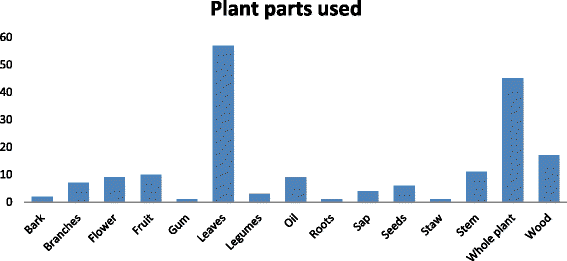An ethnopharmacological evaluation of Navapind and Shahpur Virkanin district Sheikupura, Pakistan for their herbal medicines
- PMID: 28482859
- PMCID: PMC5422909
- DOI: 10.1186/s13002-017-0151-1
An ethnopharmacological evaluation of Navapind and Shahpur Virkanin district Sheikupura, Pakistan for their herbal medicines
Abstract
Background: The chief aim of this study was to enlist the ethnobotanical uses of wild plants in district Sheikhupura, province Punjab, Pakistan. Due to extreme geographical and climatic conditions, Pakistan has a great floral diversity. Plants have been used by the indigenous people for treatment of different ailments since long. They are still dependent on the plants for their domestic purposes. Moreover, plants are used as first aid to treat diverse ailments such as cold, cough, influenza, asthma, cancer, antidote, gastric and hepatic disorders. The traditional uses of medicinal plants lead to the discovery of natural drugs. This is first quantitative ethnobotanical documentation of medicinal plants in NavaPind and ShahpurVirkan district Sheikhupura, province Punjab, Pakistan.
Methods: This ethnobotanical information was collected from about 400 informants including male and female. Sample size was determined by statistical formula. The informative data was based on semi-structured interviews, group discussions, Questionnaire and field visits. Then the data was analyzed by applying different quantitative indices such as Informant Consent Factor (ICF), Use value (UV), Relative Frequency of Citation (RFC), the Fidelity level (FL) and Jaccard Index (JI).
Results: Almost 96 plants belonging to 34 families were reported. Most-frequently cited families were Poaceae (16 species) and Fabaceae (15 species). The most dominant life form was herbs (30.20%). The most-used plant parts were leaves (31.14%), followed by whole plant (24.59%), Most common mode of administration is extraction (81.25%). Generally herbal medicines were acquired from fresh plant material. Among all 54.16% plants were toxic, 31.25% were nontoxic, whereas the remaining 14.58% may be toxic or nontoxic because of their dual attitude. Almost 34 species were reported with their different medicinal uses as has been reported in literature.
Conclusions: This ethnobotanical documentation revealed that the plants are still used by natives of rural areas in their day-to-day lives. This study provides basis for the conservation of local flora. Plants with high ICF, UV and FL can be further used for phytochemical and pharmacological studies. This documentation could provide baseline information which can be used to develop new plant-based commercial drugs.
Keywords: Ethnobotany; Fabaceae; Medicinal plant; Poaceae; Traditional knowledge.
Figures
Similar articles
-
Ethnopharmacological exploration of medicinal mushroom from Pakistan.Phytomedicine. 2019 Feb 15;54:43-55. doi: 10.1016/j.phymed.2018.09.196. Epub 2018 Sep 18. Phytomedicine. 2019. PMID: 30668382
-
Inventorization of traditional ethnobotanical uses of wild plants of Dawarian and Ratti Gali areas of District Neelum, Azad Jammu and Kashmir Pakistan.PLoS One. 2021 Jul 29;16(7):e0255010. doi: 10.1371/journal.pone.0255010. eCollection 2021. PLoS One. 2021. Retraction in: PLoS One. 2023 Jun 14;18(6):e0286781. doi: 10.1371/journal.pone.0286781. PMID: 34324561 Free PMC article. Retracted.
-
Ethnobotanical survey of the medicinal flora of Harighal, Azad Jammu & Kashmir, Pakistan.J Ethnobiol Ethnomed. 2020 Oct 27;16(1):65. doi: 10.1186/s13002-020-00417-w. J Ethnobiol Ethnomed. 2020. PMID: 33109243 Free PMC article.
-
An overview on ethnobotanico-pharmacological studies carried out in Morocco, from 1991 to 2015: Systematic review (part 1).J Ethnopharmacol. 2021 Mar 1;267:113200. doi: 10.1016/j.jep.2020.113200. Epub 2020 Aug 1. J Ethnopharmacol. 2021. PMID: 32750461
-
Traditional medicinal plants used for respiratory disorders in Pakistan: a review of the ethno-medicinal and pharmacological evidence.Chin Med. 2018 Sep 18;13:48. doi: 10.1186/s13020-018-0204-y. eCollection 2018. Chin Med. 2018. PMID: 30250499 Free PMC article. Review.
Cited by
-
Ethnobotanical studies of fodder grass resources for ruminant animals, based on the traditional knowledge of indigenous communities in Central Punjab Pakistan.J Ethnobiol Ethnomed. 2017 Oct 4;13(1):56. doi: 10.1186/s13002-017-0184-5. J Ethnobiol Ethnomed. 2017. PMID: 28978348 Free PMC article.
-
Plant-based traditional remedies and their role in public health: ethnomedicinal perspectives for a growing population.J Health Popul Nutr. 2025 Aug 20;44(1):300. doi: 10.1186/s41043-025-01036-5. J Health Popul Nutr. 2025. PMID: 40836265 Free PMC article.
-
Ethnomedicinal uses of the local flora in Chenab riverine area, Punjab province Pakistan.J Ethnobiol Ethnomed. 2019 Feb 1;15(1):7. doi: 10.1186/s13002-019-0285-4. J Ethnobiol Ethnomed. 2019. PMID: 30709360 Free PMC article.
-
Indigenous Knowledge of the Traditional Use of Aromatic and Medicinal Plants in Rif Mountains Ketama District.Evid Based Complement Alternat Med. 2023 Jul 29;2023:3977622. doi: 10.1155/2023/3977622. eCollection 2023. Evid Based Complement Alternat Med. 2023. PMID: 39281807 Free PMC article.
-
A Comprehensive Review of the Phytochemical Constituents and Bioactivities of Ocimum tenuiflorum.ScientificWorldJournal. 2024 Oct 22;2024:8895039. doi: 10.1155/2024/8895039. eCollection 2024. ScientificWorldJournal. 2024. PMID: 39473808 Free PMC article. Review.
References
-
- Ahmed H. Issues regarding the medicinal plants of Pakistan. Dyane Today. 1999; 6:6–7.
-
- Lentini F, Di Martino A, Amenta R. Le piante di usopopolarenell’ arcipelagodelle Pelagie (Ag). L’uomo e l’ambiente. 1995; 19:117–121.
MeSH terms
LinkOut - more resources
Full Text Sources
Other Literature Sources







